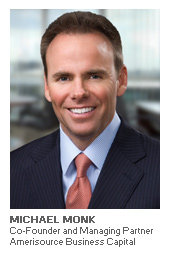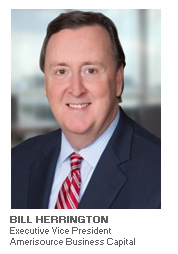
In early October, Amerisource Business Capital celebrated its 40th anniversary, having facilitated over $2.1 billion in loans to businesses across the United States. As a direct lender and a critical source of capital for small and lower middle-market companies, Amerisource has solidified its reputation as a leading independent lender, serving a diverse range of sectors within the commercial finance industry.
Throughout its four decades of operation, Amerisource has remained deeply committed to its clients and workforce, fostering strong relationships while consistently prioritizing customer satisfaction and employee development. In addition to its core business activities, the company has demonstrated a firm dedication to corporate social responsibility, actively engaging in philanthropic endeavors, volunteer efforts, and strategic community partnerships.
In an exclusive interview with ABL Advisor, Michael Monk, Co-Founder and Managing Partner, along with Bill Herrington, Executive Vice President, reflected on the company’s legacy and shared their perspectives on the shifting dynamics of the commercial finance and lending markets.
ABL Advisor: How would you describe how Amerisource has evolved since its founding in 1984? What has surprised you the most as the commercial lending industry has matured?

Michael Monk: Amerisource’s founder, Jason Floyd, originally founded the firm in 1984 as an equipment leasing shop. The company shifted its focus to working capital finance in the early 1990s, and that was still its primary offering when Jason and I partnered up in late 1998.
In the early 2000s, we added an ABL platform and a commercial real estate finance product, including capital for owner-occupied and investment properties, as well as bridge financing. Since then, we’ve continued to add additional capabilities (both organically and through acquisitions) to deliver our private credit solutions to growing companies and sponsors. These products have been driven primarily by client demands and market opportunities. Today, we have financing platforms for commercial insurance premium finance, machinery and equipment (including the transportation sector), Fund/NAV finance, cash flow finance (including SaaS and recurring revenue finance), and a number of other creative structures that we’ve utilized to provide solutions for the market.
It’s been interesting to observe the consolidation over the last 40 years as the commercial lending market has matured. There was a period of time where vast numbers of independent private credit lenders were gobbled up by banks and operated as divisions within the banks. Over the past few years, we’ve seen massive private institutional funding pour back into nonbank lending platforms. It will be really interesting to see how banks respond in the coming years to the loss of so much market share to private credit providers.
ABL Advisor: Amerisource has diversified into the private equity space with the establishment of the Amerisource Opportunity Fund which will support independent sponsor equity investors. Please tell us about this expansion and why this is part of the company's strategy?

Bill Herrington: Our equity investments are a smaller portion of our portfolio, but we made our first equity investment over two decades ago. Since then, the portfolio of investments has increased steadily, and we are pleased with the results. We made the decision a year or so ago to expand and consolidate this initiative, so we formed the Opportunity Fund to allow outside investors to participate in our activities. We position ourselves as a one-stop capital source for lower middle market companies, so this was a logical step in that direction.
Monk: In 2021, we launched our credit fund (Amerisource Secured Income Fund, LP) under a perpetual/evergreen structure, and we’ve been very pleased with the results and returns to our network of family offices and high net worth individuals. Ee launched our equity fund (Amerisource Opportunity Fund, LP), also under a perpetual/evergreen structure, which is a unique feature for an equity fund. We’ve been investing on the equity side for decades now, so this new fund was a strategic move to add scale to this platform.
ABL Advisor: Since its founding in 1984, Amerisource has experienced multiple economic cycles. How would you describe the current lending environment, and how has it changed over the past 5 years in particular?
Monk: The current lending and investment environment is really exciting. There are many economic and industry sectors where private lending platforms can compete quite effectively against banks. We are finding that many sponsors, particularly independent sponsors, would prefer to work with Amerisource on the debt side for speed, flexibility and certainty of close. And of course, our ability to bring equity co-investment dollars to the table provides an enhanced competitive advantage.
ABL Advisor: How has the influx of private debt, private credit, private equity and other independent specialty lenders transformed borrower expectations?
Herrington: When I started my banking career there were over 14,000 banks in the US. That number has steadily declined to around 4,500 today. The private credit and private equity market was significantly smaller than it is now. Although private credit metrics are less transparent than commercial banking figures, most reporting now indicates private credit to now exceed $1 trillion – which would be roughly equivalent to the high yield market. So, borrowers today have more options than ever before outside of traditional banking.
Monk: I agree with Bill’s comments. Borrowers and sponsors definitely have more options than ever. And it’s one of the primary reasons we have invested in developing platforms to provide a “one-stop shop” solution. Being able to provide working capital against receivables and inventory, leverage against physical assets and real estate, and cash flow term financing to get a deal done is a huge advantage in the marketplace for us. And Amerisource having the ability to co-invest on the equity raise can be a determining factor for an equity sponsor or investment banker looking for simplicity, certainty of close and a comprehensive solution.
Of course, there will always be borrowers and investment bankers that want to cobble a deal together from several different lending sources, and that’s perfectly fine with us. We are happy to share the deal with another lender if that structure and terms work best for the borrower. We ”play nice in the sandbox” and are generally easy for other lenders to work with.
ABL Advisor: One of Amerisource's areas of specialization is working with turnaround and special situation credits. Have you seen more activity in this segment over the past 2 years, and if yes, what do you believe are the major factors causing growth in the distressed debt market?
Monk: While we have a good track record working with turnarounds and special credit situations, those are not normally the deals we are actively pursuing. We are generally looking for growth companies — those looking to expand their business, either organically or through acquisition. Those situations tend to have more opportunities to utilize our flexible financing structures and ability to scale with the borrower quickly. We are also more interested in equity co-investments for these growth companies. Having said that, we do have extensive ABL, restructuring and workout capabilities. This makes us a very reliable and stable partner for a company or sponsor looking for financing in a turnaround situation. However, monitoring these types of deals can be very taxing on our most valuable resource — our human capital — so it’s important for us to really see the upside potential of a turnaround credit. It’s not so much about pricing/yield — it’s more about the prospects of improving the borrower to a more stable financial situation and, hopefully, the ability to get back on the growth trajectory with more opportunities to provide growth capital.
ABL Advisor: As you look ahead after 40 years, where do you both see the greatest areas of opportunity in the direct lending space for Amerisource?
Herrington: Traditional commercial banking is a highly regulated industry and I don’t see regulatory relief coming anytime soon. In fact, due in part to the liquidity issues banks experienced a year or so ago, I think it is more likely that banks will become even more regulated, not less. With the rapid expansion in private credit combined with the contraction in the number of U.S. banks, the market is essentially saying that commercial banks cannot fill commercial credit demand. I’m not sure where we reach equilibrium between banks and private credit, but in my opinion the expansion of private credit has not reached its peak, and we are excited about the future across all asset classes.
Monk: Bill is spot on. We expect to see more and more opportunities as banks continue to reshuffle and evaluate where they fit in the commercial financing picture. Many of the newer private credit strategies are really just throwing capital at “the latest thing,” buying assets from portfolio originators, but with no real credit/portfolio management expertise. The holders of this debt often don’t have strong workout expertise and experience, so it remains to be seen what will happen when a downturn hits and delinquency rates go up.
Our strategy is fairly simple — continuing to expand and diversify our financing product offerings and fill the gaps where financing is needed in the marketplace.
ABL Advisor: What are some of the lessons learned over the past 40 years that help inform your decision making today?
Monk: A few lessons we’ve learned over the years include:
(1) We are a credit shop, first and foremost. Credit problems are inevitable (and anyone who tells you otherwise hasn’t been in this business very long!). But we have 200+ years of combined credit and workout experience in our senior management team, and everything we do is built upon a foundation of credit quality and risk management. We have a tremendous credit performance history, with charge-off rates lower than average commercial bank charge-off rates in 7 of the last 9 years. Our stakeholders know that credit culture underpins everything we do, so it gives us a lot of confidence when dealing with a trouble credit, as well as pursuing creative structures and new initiatives.
(2) We’ve learned to invest in and take care of our people. Our organization is a family, and we recognize and appreciate that we also all have our own families at home. We look to foster this family culture in everything we do. Whether in originations, credit, underwriting, portfolio, collateral, accounting or legal, we are looking for the best people out there — not just the brightest, but also those who fit our family culture. Over the years, we’ve developed a strong and seasoned core management team — 33 percent of our team members have been with us for over 10 years, and 10 percent have been with us over 20 years.
(3) You can’t be afraid to try something new. And you have to be willing to make a few mistakes along the way, taking calculated risks where the upside justifies the expense and downside. The financing market is always changing and evolving — those who don’t adapt will have a tough time maintaining portfolio assets, and an even tougher timer trying to sustain growth.